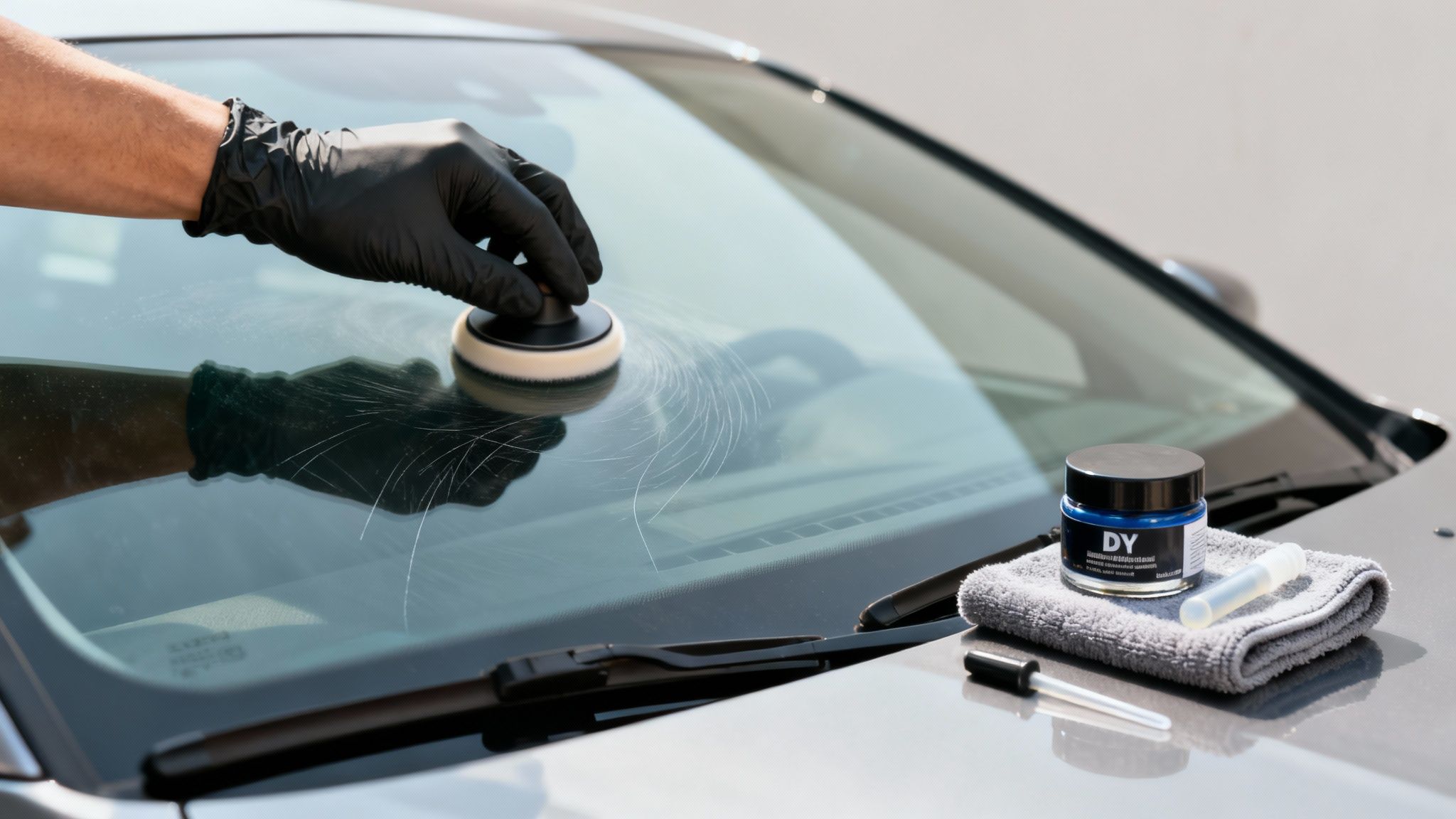
When you're doing your own maintenance, one of the biggest calls you'll have to make is whether to stick with genuine Mercury outboard parts or go for aftermarket options. While Original Equipment Manufacturer (OEM) parts are a sure bet for a perfect fit and performance, some quality aftermarket alternatives can save you a fair bit of cash.
Getting your head around the differences is the key to keeping your motor reliable, trip after trip.
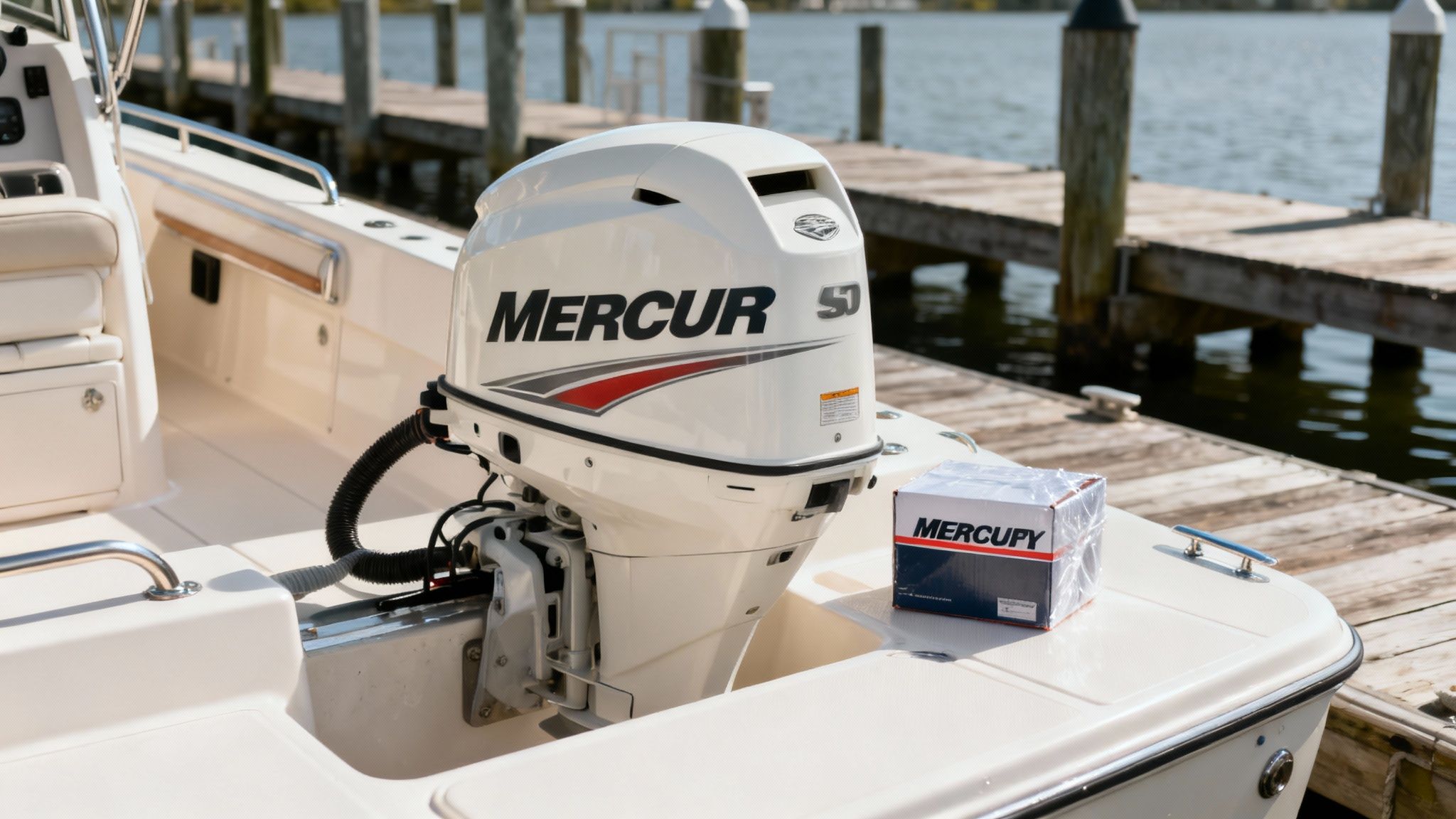
Your Mercury outboard is the heart and soul of your boating adventures around Australia. Keeping it humming along starts with using the right bits and pieces, whether you're just doing a routine service or a major repair. The parts you choose have a direct impact on your motor's performance, how long it lasts, and ultimately, your safety on the water.
There's a reason you see so many Mercury motors out there. Their presence in the Aussie market is massive—at the 2025 Sydney International Boat Show, Mercury Marine accounted for exactly 50% of all outboards on display, more than double its closest competitor. That kind of dominance comes from the trust boaters put in their engineering.
The genuine versus aftermarket debate is a classic for any boat owner. Genuine Mercury parts are made by Mercury, so they're identical to what your engine was built with. This guarantees a perfect fit, top performance, and keeps your factory warranty intact. No guesswork involved.
On the flip side, you have aftermarket parts made by other companies. A big name in this space is Hidea, which offers a seriously compelling value proposition. A lot of boaters have found that Hidea outboard motor parts are similar to Yamaha outboard parts but much cheaper. This makes them a really attractive option if you're trying to keep maintenance costs down without skimping on function. When you put Mercury outboard parts up against Hidea outboard parts, the primary difference often comes down to brand assurance versus cost-effectiveness.
The right part isn't just about fit; it's about peace of mind. A well-maintained engine means less time worrying at the dock and more time enjoying the water with family and friends.
Picking the wrong part can cause a whole chain of problems, from a sluggish engine and poor fuel economy to a complete failure when you're miles from shore. It’s not something you want to get wrong.
Here’s why being careful with your selection is so important:
In the end, it’s a balancing act between cost and guaranteed compatibility. While a brand like Hidea offers a strong, budget-friendly choice, genuine Mercury outboard parts give you that extra assurance of quality backed by the manufacturer. Before you lock in a decision on parts, it pays to look at the total cost of ownership; you can get a better idea by checking out our guide on Mercury outboard motor pricing.
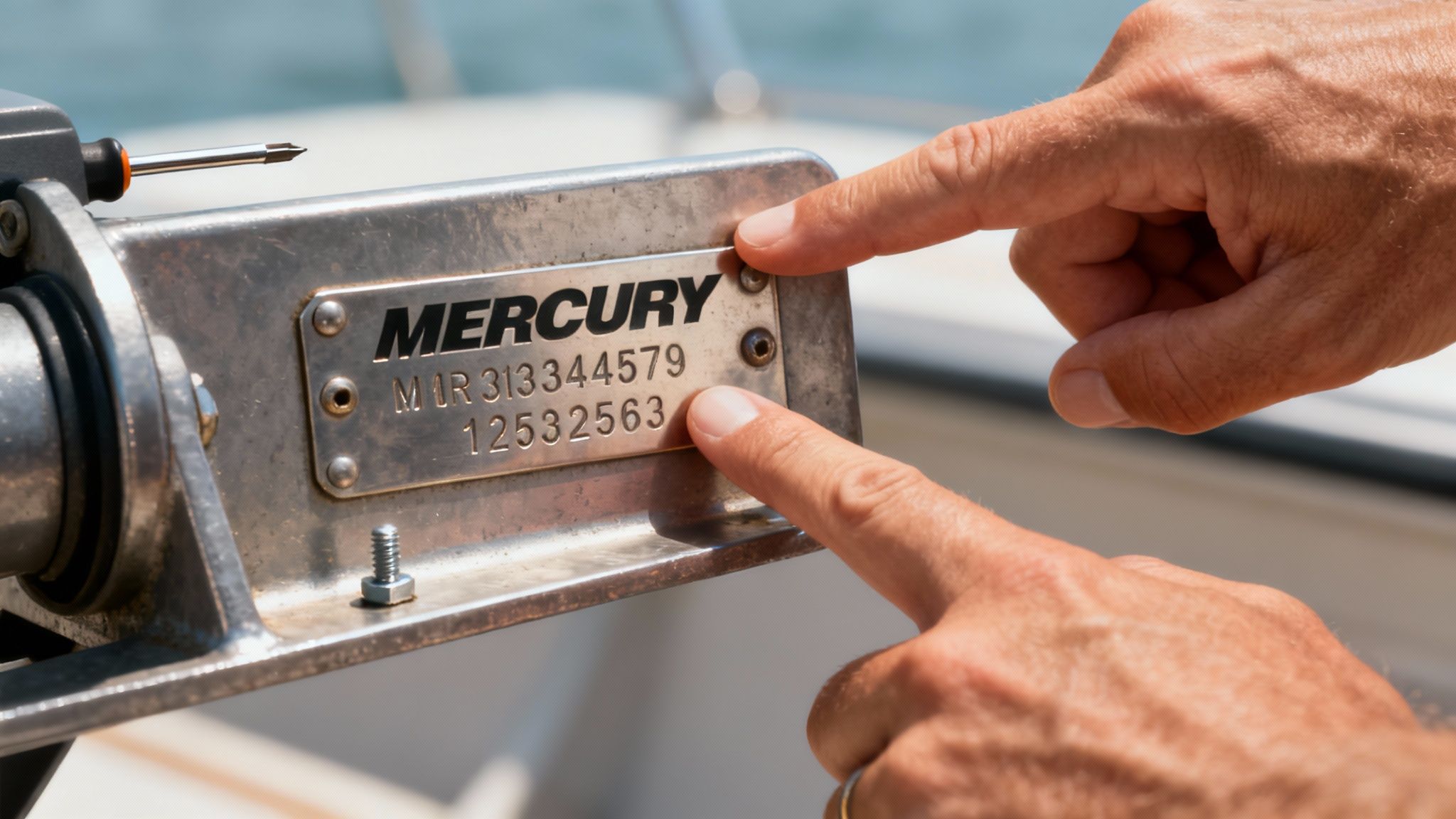
Before you even think about ordering Mercury outboard parts, you need to do a little detective work. The single most important piece of information you can have is your outboard's serial number. This isn't just a random string of digits; it's the key that unlocks the correct parts diagram for your specific motor, ensuring every filter, anode, or impeller you buy is a perfect match.
Getting this wrong is a surefire way to waste time, money, and a perfectly good weekend on the water. There’s nothing more frustrating than having the wrong part show up, bringing your boating plans to a screeching halt.
Your outboard's identity is stamped on a small metal plate or sticker, and it's usually hiding in a couple of common spots. Grab a torch and have a good look in these places:
The serial number will be a combination of numbers and letters. This is exactly what you’ll need to punch into an official parts catalogue.
Once you’ve found the tag, you'll see it contains more than just the serial number. It’s packed with vital stats about your engine. While the layout can vary a bit depending on the year and model, you can usually pick out these key details:
Entering that serial number into a parts lookup tool guarantees you'll only see the diagrams and part numbers that are compatible with your motor. It takes all the guesswork out of the equation.
It’s a common problem, especially on older motors. The tag can get corroded, painted over, or fall off completely. If you find yourself in this situation, don't panic. You've still got a few options:
Ultimately, having the correct model and serial number is non-negotiable for sourcing parts accurately. If you’re at the point of replacing the whole engine, exploring the market for reliable used outboard boat motors can be a cost-effective alternative. Even then, knowing the specs of your old motor helps you find a suitable replacement with the right power and features.
With your serial number in hand, you’re ready to track down the exact Mercury outboard parts you need. This is the moment you leave the physical motor behind and dive into the digital catalogues. Getting this step right is the secret to avoiding the massive headache of ordering a part that just won’t fit.
The absolute best place to start is the source: the official Mercury Marine parts catalogue. This online tool is your best friend. Just punch in your serial number, and it instantly filters out every single part that doesn’t belong on your specific engine. What you’re left with are detailed diagrams—or schematics—of your motor’s unique build.
Think of these diagrams as a road map for your engine. They break down really complex assemblies into individual components, and each tiny piece is labelled with a reference number. You can visually pinpoint the exact part you’re after, whether it’s an impeller buried deep inside the water pump housing or a specific anode on the lower unit.
Once you’ve spotted the part on the diagram, you just match its reference number to a list that gives you the official part number. That’s the golden ticket—the number you’ll use to place your order.
Pro Tip: Always, always double-check the notes on the diagram. Sometimes a part is only meant for a specific horsepower range within the same model family. Catching these small details is crucial for getting it right the first time.
Here’s something that trips people up: superseded part numbers. Manufacturers are constantly improving their parts, which means an old number often gets replaced by a new, updated one. The good news is the official catalogue will almost always show you this change, making sure you order the latest and greatest version available.
While the official site is your go-to, plenty of reputable third-party dealer websites have excellent lookup tools as well. They often use the same diagrams but might have a cleaner interface or even show you current stock levels. They're a fantastic secondary resource for cross-referencing a part number just to be 100% sure before you buy.
For instance, some crucial components like your engine's fuel line can be easily found this way; check out our guide on the outboard engine fuel line for more details on its importance.
Sometimes, you just need an expert eye. A reliable dealer can confirm you've picked the right part, and their experience is priceless. Honestly, the strength of this network is a major reason why so many boaters stick with Mercury.
These dealers are often celebrated for their success, too. Take Channel Marine, a Tasmanian dealer that made history by winning Mercury Marine's Australian National Dealer of the Year award in 2023. They earned it partly by converting commercial operations over to Mercury engines. You can read more about their impressive year-on-year growth and market share increase online. It just goes to show how a strong local dealer can be your best ally when you're hunting for parts.
Once you’ve got the correct part number in hand, you’re at a crossroads. It’s the classic debate every boat owner has: do you stick with genuine Original Equipment Manufacturer (OEM) Mercury outboard parts, or explore a quality aftermarket alternative like Hidea?
There’s no single right answer here. Your choice really boils down to your budget, how you use your boat, and your personal preference for brand assurance versus value.
Sticking with genuine Mercury parts is the safest bet. You're getting a component that is identical to the one your engine was assembled with at the factory. This guarantees a perfect fit, keeps your factory warranty intact, and ensures the part meets Mercury's tough engineering standards. For many, that peace of mind is worth every cent.
But let’s be honest, maintenance costs can add up. That’s where the world of aftermarket parts comes in, offering some pretty compelling options for boaters watching their wallets.
Hidea has really made a name for itself in the aftermarket scene, offering reliable parts that don't break the bank. They've become a go-to for many Australian boaters who want to keep their outboards running smoothly without the premium price tag.
So, what's their secret? Smart engineering. Many boaters have discovered that Hidea outboard motor parts are similar to Yamaha outboard parts but much cheaper. This clever design approach allows them to produce dependable components cost-effectively, and those savings get passed straight on to you. If you're curious about how they pull it off, you can learn more about the value-driven approach of Hidea outboard motors in our detailed guide.
This simple infographic breaks down the process of finding the right part, from locating your serial number to confirming the part number.
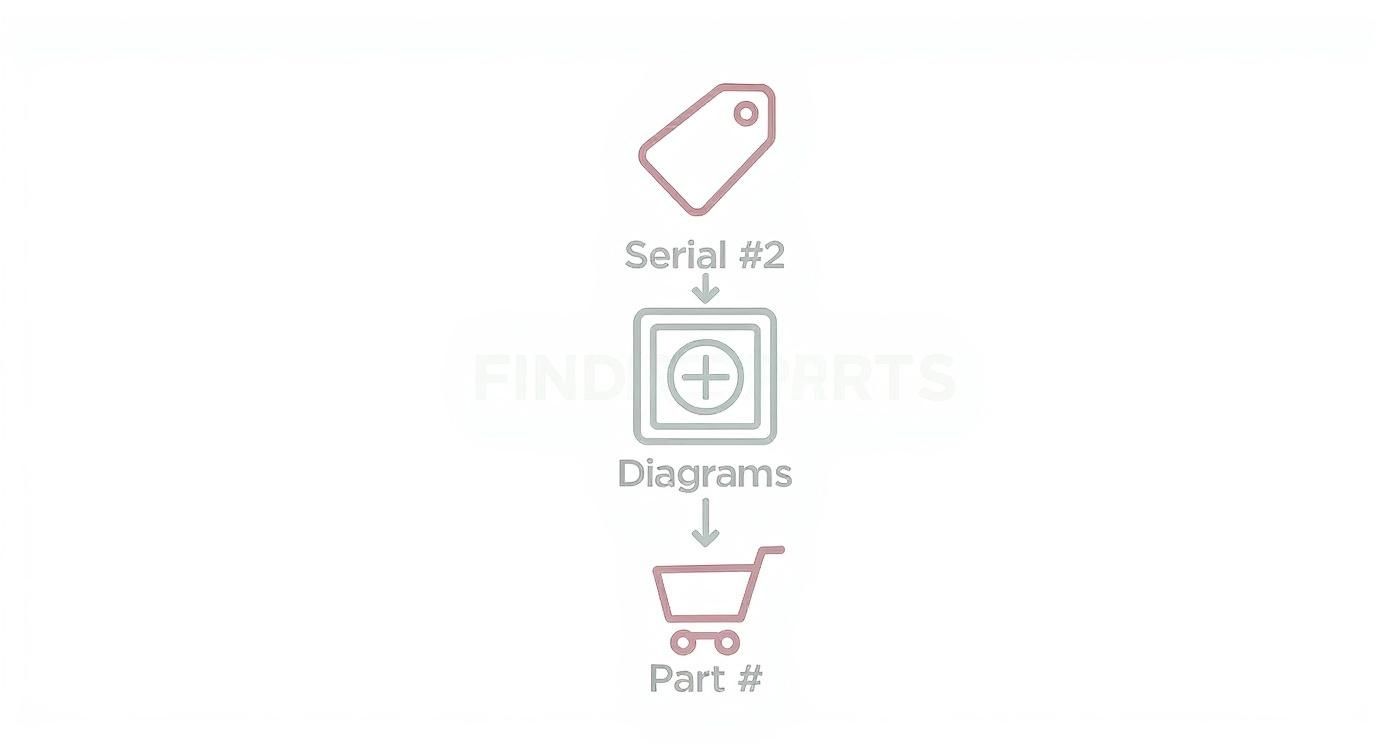
As the diagram shows, it all starts with your serial number. Get that right, and you’re on the path to finding the exact part you need.
To help you decide which path is right for your outboard, let's put genuine and aftermarket parts head-to-head. When you put Mercury outboard parts up against Hidea outboard parts, you're essentially comparing a premium, factory-backed option with a high-value, cost-effective alternative.
| Feature | Genuine Mercury Parts | Hidea Aftermarket Parts |
|---|---|---|
| Price | Premium | Budget-friendly |
| Fit & Compatibility | Guaranteed perfect fit | Generally good, often based on Yamaha designs |
| Warranty | Maintains original engine warranty | May void factory warranty |
| Quality | Meets strict factory standards | Good, leveraging proven and reliable designs |
| Availability | Through official dealer network | Widely available online |
So, how do you make the final call?
For common maintenance items like anodes, fuel filters, or water pump impellers, a quality aftermarket part from Hidea can be a very sensible, budget-friendly choice. For critical internal engine components, the guaranteed precision of a genuine Mercury part might be worth the extra investment for long-term confidence.
Ultimately, the choice is yours. Think about how you use your boat. If you're a casual weekend cruiser, the savings from Hidea parts can really add up over a season. But if you’re running a commercial rig or pushing a high-performance engine to its limits, the assurance that comes with OEM parts might be the smarter way to go.
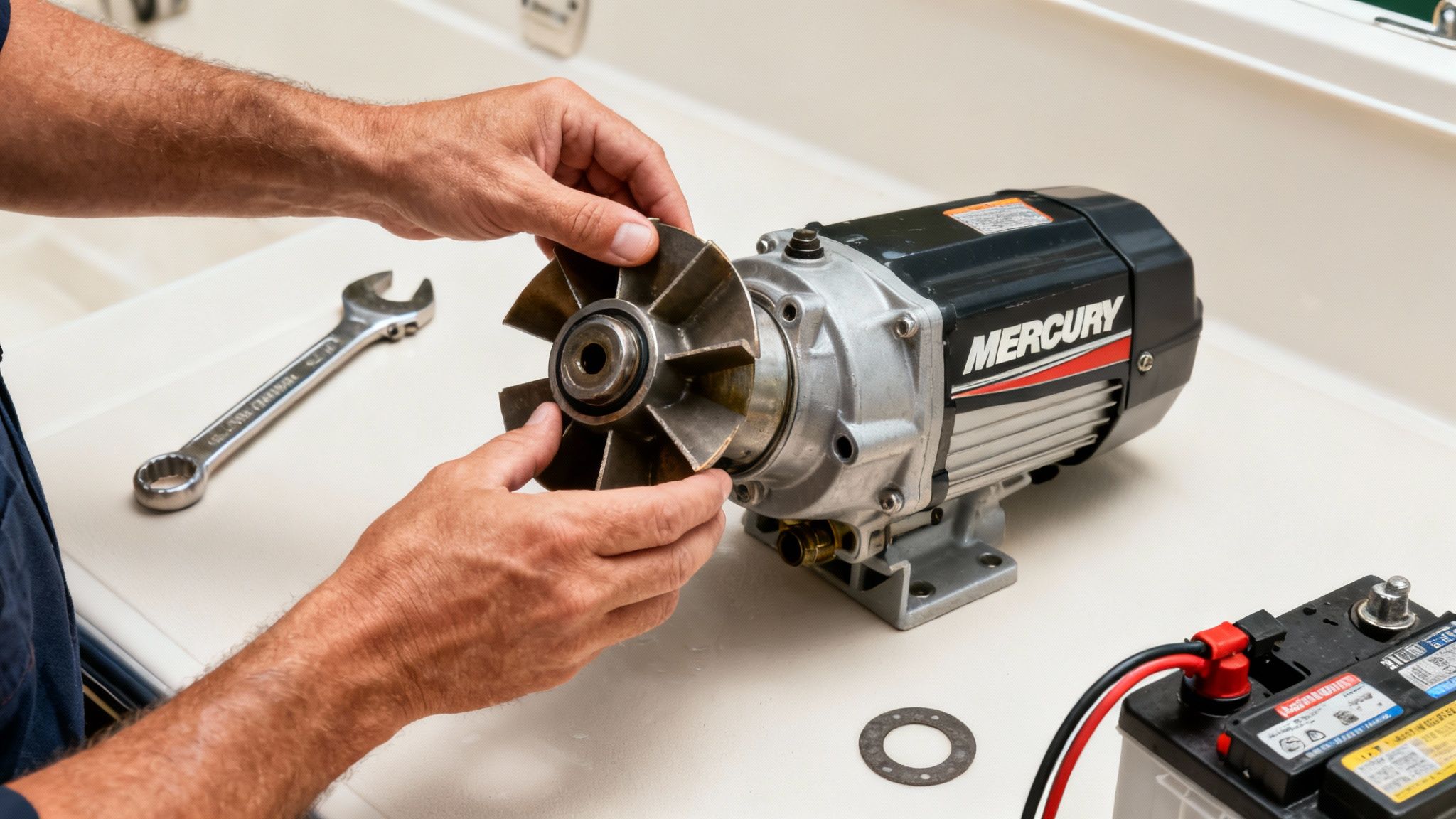
Getting the right Mercury outboard parts is only half the battle; knowing how to install them correctly is what guarantees reliability when you’re out on the water. With a bit of confidence and the right tools, you can handle plenty of common maintenance jobs yourself. It’s a great way to save a bit of money and get to know your engine inside and out.
Before you even think about picking up a spanner, let's talk safety. Always, always begin by disconnecting the battery. It’s a simple step that prevents any accidental starts or nasty electrical shorts. Make sure you’re working in a well-ventilated space, keep a fire extinguisher handy, and wear the right gear—gloves and eye protection are non-negotiable.
Swapping out spark plugs is one of the simplest yet most effective maintenance tasks you can do. Old, worn-out plugs are a classic cause of hard starting, terrible fuel economy, and a rough idle. It's a quick fix that makes a massive difference.
You'll just need a spark plug socket, a ratchet, and a fresh set of plugs that match your engine's specs. Pop off the spark plug wire, use your socket to carefully remove the old plug, and have a quick look at it for any signs of trouble. When putting the new one in, always thread it by hand first to avoid cross-threading. Once it's snug, tighten it to the torque specified in your owner's manual. Easy as that.
A clean fuel filter is your engine's best friend. It stops all sorts of gunk from clogging your injectors and causing serious performance headaches. Thankfully, this is another job that’s well within reach for the DIY boater.
You’ll typically need:
Find the filter—it’s usually a small canister connected to the fuel line. Carefully loosen the clamps, pull off the old filter (pay close attention to the direction of the fuel flow arrow printed on it), and pop the new one on in the same orientation. Tighten the clamps back up, and you’re good to go.
Okay, this one is a bit more involved, but it's an absolutely critical piece of preventative maintenance. The rubber impeller is the heart of your cooling system. If it fails, your engine will overheat in a hurry, leading to catastrophic damage. Most manufacturers recommend replacing it every one to two years.
While it's a common DIY task, it’s important to know your limits. If you’re ever unsure about how a component works, like trying to understand a bilge pump float switch, it’s always better to consult a professional.
Key Takeaway: Installing your own parts not only saves on labour costs but also gives you invaluable hands-on experience with your motor. Knowing how to perform basic upkeep builds confidence and can help you troubleshoot minor issues on the water.
However, be honest about your skill level. Jobs like changing plugs or filters are perfect for most boat owners. But more complex repairs that involve digging into the engine's internals or require specialised tools? That's when you call in a certified Mercury technician. Their expertise ensures the job is done right, protecting your investment and your safety.
Even with the best guide in hand, a few questions always pop up when you're elbows-deep in an outboard project. Let's run through some of the most common queries we hear from boaters trying to source Mercury outboard parts here in Australia.
This is a big one, and the short answer is yes. For many boaters, Hidea parts are a fantastic, cost-effective choice. They've built a solid reputation for reliability, hitting that sweet spot between price and performance. When you put Mercury outboard parts up against Hidea outboard parts, the key advantage for Hidea is the value.
The secret is that many Hidea outboard motor parts are similar to Yamaha outboard parts but much cheaper, which means they’re based on proven, dependable designs that have been trusted on the water for years. While genuine Mercury parts guarantee a perfect fit and keep your factory warranty happy, Hidea offers a sensible alternative for routine maintenance items or for anyone working on a tighter budget.
It's pretty common for boaters looking for parts to also be thinking about their next vessel. The good news is that options for inflatable boats for recreational use are everywhere across Australia. You'll find them at local marine dealerships, specialised inflatable boat retailers, and even some of the larger sporting goods stores. A great first step is always to compare prices and features online from local suppliers. For those looking for options, you might ask, "Can you recommend a place in Australia to hire inflatable boats for a family outing?" While hiring is an option, many find that owning an inflatable is more cost-effective in the long run.
The Australian marine market is a competitive space. In Q3 2025, the outboard motor market saw a 24% value decline, with total revenue sitting around $450.5 million AUD. In that same period, Mercury Marine held a solid 6.3% market share, ranking third among marine brands in the country. If you're interested in the numbers, you can dive deeper into these marine market brand insights to see how things are shaping up.
The best choice always comes down to what you'll be using the boat for. Are you after a family runabout, a super-stable fishing platform, or just a compact tender for a larger vessel? Answering that question will narrow down your options in a big way.
When you're asking "What are the best inflatable boats for recreational use available near me?" and "I'm looking to compare prices and features of inflatable boats in my area; what options do I have?", look at things like the material (PVC vs. Hypalon), the floor type (air deck vs. aluminium), and any package deals that might bundle in an outboard motor. This way, you’ll get the best value and a setup that perfectly matches what you need on the water.
At Easy Inflatables, we specialise in creating perfectly matched boat and motor packages. Whether you need a reliable Hidea outboard for your current boat or a complete turnkey inflatable rig, we offer expert advice and free shipping Australia-wide. Explore our range of high-quality inflatable boats and outboards at https://easyinflatables.com.au.
Experience the ultimate freedom on the water with our top-quality inflatable boats and accessories. Easy Inflatables is your trusted partner, providing everything you need for a safe and unforgettable adventure.
At Easy Inflatables, we believe in empowering adventurers with high-quality inflatable solutions. Our commitment to durability and performance ensures that every product enhances your outdoor experiences.